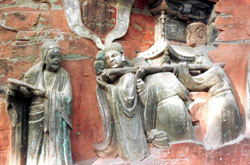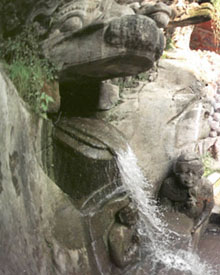 |
 |

Dazu stone sculptures in Southwest China's Chongqing Municipality is listed as one of the World Heritage sites December 2. The title of "World Heritage Site" is approved by the United Nations Education, Science and Culture Organization (Unesco). It is the highest honour any country can receive for the levels of its civilization and cultural relics protection technologies and management. The more than 50,000 stone sculptures in Dazu (which literallmeans "Big Foot" in Chinese) in the northwest of Chongqing, provide a faithful and complete record of how Buddhism gradually gained popularity in Southwest China more than 1,000 years ago, said Wang. The majority were carved during the late Tang Dynasty (618-907 AD) and the Song Dynasty (960-1279). The Dazu sculptures marked the second consummate level of carving arts in Chinese history. The first pinnacle of carving arts was represented by sculptures in Dunhuang, Gansu Province, which were created in the Sui Dynasty (581-618 AD) and the early Tang Dynasty. Unesco experts were particularly interested in sculptures that portrayed ordinary people in their daily life. They rejoiced at seeing details of farmers' everyday lives and work, their farming tools and household utensils as well as their dress habits, which are of great historical value. The Dazu sculptures retain their vividness and colours more than 1,000 years after they were created, thanks to the meticulous care given by Chinese cultural experts over the past four decades.   |
Please visit People's Daily Online --- http://www.peopledaily.com.cn/english/